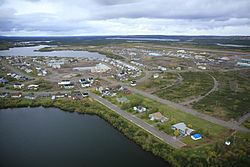RCM Caniapiscau Constituted August 1, 1955 Area 39 km² Province Québec | Settled 1953 Time zone EST (UTC−5) Population 213 (2011) Local time Thursday 11:10 PM | |
 | ||
Weather -19°C, Wind W at 16 km/h, 60% Humidity | ||
Schefferville is a town in the Canadian province of Quebec. Schefferville is in the heart of the Naskapi and Innu territory in northern Quebec, less than 2 km from the border with Labrador on the north shore of Knob Lake. It is located within the Caniapiscau Regional County Municipality and has an area of 25.11 square kilometres (9.70 sq mi). Schefferville completely surrounds the autonomous community of Matimekosh and it abuts the small community of Lac-John Reserve. Both communities are First Nations reserves. It is also close to the Naskapi reserved land of Kawawachikamach.
Contents
- Map of Schefferville QC Canada
- History
- Demographics
- Notable residents
- Recent developments
- Climate
- References
Map of Schefferville, QC, Canada
The isolated town is not connected to the provincial road network but is accessible by airplane via the Schefferville Airport or by train. Schefferville is the northern terminus of Tshiuetin Rail Transportation (formerly operated by the Quebec North Shore & Labrador (QNS&L) Railway) with service to Sept-Îles.
McGill University operates the McGill Subarctic Research Station in Schefferville.
History
Schefferville was established as a town by the Iron Ore Company Of Canada in 1954 to support the mining of rich iron ore deposits in the area. The original settlement was called "Burnt Creek" and was located some miles to the north of the current location of the town of Schefferville. When the plans were drawn up for the town, it was originally called "Knob Lake" after a prominent iron ore outcropping visible on a prominent hill south of the town site, but the name Schefferville was adopted in honour of (Roman Catholic) Bishop Lionel Scheffer, who served as the Vicar Apostolic of Labrador from March 14, 1946, until his death on October 3, 1966.
At the time of the town's founding, Innu from Maliotenam and Naskapi from Fort Chimo were resettled to Schefferville to assist with geological exploration work and the railway construction. Following many years of neglect and destitute poverty, in 1968 parts of the town were set aside for them as a reserve. By 1972, housing units had been built, and most of the Naskapi and Innu moved to this new site, known today as Matimekosh Reserve.
For some years in the late 1950s, NORAD operated a radar station in Schefferville as part of the Mid-Canada Line, part of North America's defences against possible Soviet attack across the arctic.
At its peak in the late 1960s, Schefferville counted some 5,000 residents. But iron ore mining ceased there in 1982, on orders from the then president of the Iron Ore Company, Brian Mulroney, who later became Prime Minister of Canada. Most of the 4,000 or so non-aboriginal occupants left, leaving mostly aboriginal people who had settled there in the preceding 30 years. In 1986, the town even ceased to exist as an incorporated legal entity, but this decision was reversed in 1990. Some houses and public facilities were demolished, while other parts of the infrastructure were added to the Matimekosh Reserve. Many of the remaining houses in the town are used by companies in the iron industry to house their staff.
Demographics
At the Canada 2011 Census, Schefferville had a population of 213 inhabitants, an increase of 5.4 percent from the 2006 census total of 202. In comparison, Matimekosh had a population of 540 and Lac-John, 21. The town counted 110 private dwellings occupied by usual residents out of a total of 178.
Many Naskapi first nation people mostly live in the village of Kawawachikamach, northwest of Schefferville. They are mostly Anglican and Protestant and speak English as their second language. The other first nation, residing mainly in Schefferville and Matimekosh, are Innu who are largely Roman Catholic and speak French as their second language.
Naskapi and Montagnais/Innu are, generally, mutually intelligible. Most local inhabitants are able to speak varying amounts of all the local languages, and code-switching is common in conversation. The breakdown of mother tongues is:
Population trend:
Notable residents
Albert Cormier was the police commissioner of Schefferville and the superintendent of Iron Ore Co. He died in May 2008 at the age of 79.
The controversial mid-20th century Quebec premier, Maurice Duplessis, died in Schefferville on September 7, 1959. His government was defeated the following year while being led by his second of two successors, the first having died in January 1960.
Recent developments
As a result of increased demand for steel and iron ore there are currently two official projects to re-establish mining operations out of Schefferville.
The first is the LabMag Iron Ore Project in Labrador, 30 kilometres west of Schefferville. The objective is to develop mining and concentrating near Schefferville that will mine 33 million tonnes of crude iron ore per year to produce 10 million tonnes per year of concentrate and pellets for a minimum of 20 years. Actual mining production began in 2011. The Naskapi Nation of Kawawachikamach owns 20% of The LabMag Iron Ore Project.
In addition, Anglesey Mining is awaiting the grant of final operational permits on its former Iron Ore Company of Canada deposits. Production is scheduled to start during late summer 2010, with output rising to two or three million tons of ore a year by 2012 before further deposits are developed. Innu protesters blocked access to Schefferville in July 2010 and delayed mining preparation with demands for increased compensation for the commercial exploitation of their traditional homelands.
Climate
Schefferville experiences a subarctic climate (Köppen Dfc). Schefferville has cool summers relative to its latitude and inland location.
